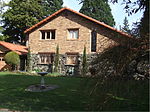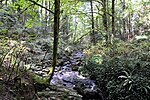Lake Oswego, Oregon
1847 establishments in Oregon Country1910 establishments in OregonCities in Clackamas County, OregonCities in Multnomah County, OregonCities in Oregon ... and 6 more
Cities in Washington County, OregonLake Oswego, OregonPopulated places established in 1847Populated places established in 1910Populated places on the Willamette RiverPortland metropolitan area

Lake Oswego () is a city in the U.S. state of Oregon, primarily in Clackamas County, with small portions extending into neighboring Multnomah and Washington counties. Located about 8 miles (13 km) south of Portland and surrounding the 405-acre (164 ha) Oswego Lake, the town was founded in 1847 and incorporated as Oswego in 1910. The city was the hub of Oregon's brief iron industry in the late 19th century, and is today a suburb of Portland. The population in 2010 was 36,619, a 3.8% increase over the 2000 population of 35,278.
Excerpt from the Wikipedia article Lake Oswego, Oregon (License: CC BY-SA 3.0, Authors, Images).Lake Oswego, Oregon
4th Street,
Geographical coordinates (GPS) Address Nearby Places Show on map
Geographical coordinates (GPS)
| Latitude | Longitude |
|---|---|
| N 45.41956 ° | E -122.66755 ° |
Address
4th Street
97034 , Forest Hills - First Addition
Oregon, United States
Open on Google Maps









